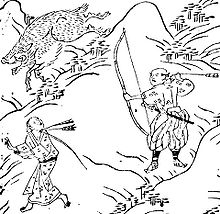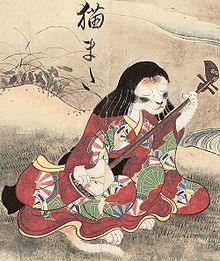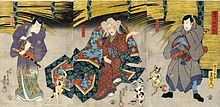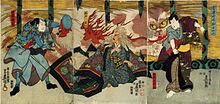
Nekomata
Share
A nekomata (Japanese 猫股 or 猫又; from Japanese neko "cat" and mata "forked" or "forked cat"; thus, in full, "forked cat") is a fictional being from Japanese folklore that can evolve from a domestic cat, but is also said to dwell wildly in certain mountainous regions of Japan and China. It belongs to the group of higher demons, the Yōkai.
The Nekomata is considered to be a relative of the Bakeneko (also a magical cat demon), although the transitions are fluid and the Nekomata are very often confused with the Bakeneko. Only the double or forked tail should ensure a distinction.
Nekomata are considered malevolent in traditional folk belief, in contrast to the maneki neko, the "waving cat," which is said to bring good luck. Belief in nekomata is found in both Buddhism and Shintoism. Cat demons comparable to Nekomata are also known from Chinese mythology.
Tales and legends about alleged encounters with nekomata have been handed down at least since the early author Yoshida Kenkō (1283-1350) of the transitional period from the Kamakura period (1185-1333) to the beginning of the Muromachi period (1336-1573).
Nekomata Backgrounds
Etymology
Of the various writing systems used to write Japanese, two are significant to the etymology of "Nekomata": kanji (characters adopted from Chinese writing) and hiragana (a Japanese syllabic script). The oldest spelling of the name "Nekomata" was a combination of the kanji, 猫 (neko) for "cat" and the two hiragana characters また (mata).
A later spelling used the two kanji 猫股. The second kanji has the meaning "forked" or "bifurcated" and together the kanji - in reference to the double tail - give the descriptive term "forked cat". The most common spelling, however, is with the kanji 猫又. Again, the first kanji stands for "cat".
There are different explanations for the meaning of the second. One explains the second kanji with the meaning of the counting word mata wa ("multiple", "repeat", but also "either or") and refers to the double tail of the demon. The second explanation refers to the meaning of the kanji 又 in the sense of "again" or "also".
The "again-cat" or "also-cat", also translated as "revenant-cat", would thus be due to the superstition, widespread among the people, that a cat possessed several lives.
Both kanji, 股 and 又, are later additions. Most probably they are an attempt to offer explanations for a word handed down from the past, whose actual meaning was lost by the deviations within the traditions (so-called silence-post-principle), so that between word origin and today's designation no clear reference can be established any longer.
The exact origin of the name Nekomata is therefore not handed down. However, since mata also means "forked" or "forked," which most closely matches the demon's appearance, the Japanese name Nekomata is commonly translated in modern literature as "forked cat."
Nekomata Traditional description
According to Japanese folklore, nekomata are said to be very similar to an ordinary cat, but they are notable for their unusual size and for having two tails. They are said to occur when a domestic cat becomes unusually old (usually older than three and thirteen years, respectively) or obese and heavier than eight pounds (equivalent to 4 kg).
It is also said that nekomata, when they feel unobserved, walk upright on two legs. They are also said to be able to transform into old women. Furthermore, they are said to have certain black magic powers:
for example, they can bewitch non-magical house cats, summon hitodama, and feed on the blood of their owners (similar to vampires). In Chinese folklore, it is said that the tails of a nekomata would turn into snakes during the night, which is why it became fashionable to dock the tails of domestic cats as early as the early 11th century. Around 1602, this was banned by imperial decree.
Nekomata Different forms
Japanese folklore additionally distinguishes roughly between two forms of nekomata: one lives as a wild animal in the mountains, while the other form lives in houses and evolves from the domestic cat. It can be observed that the body size of the nekomata increases over time in the traditions.
In 1685, the Shinchomonshū reported a nekomata caught in the mountains of Kii Province to have been approximately the size of a wild boar; in 1775, the Wakun no shiori reported the roar of a nekomata heard from the mountains, whereupon it was assumed to be the size of a lion or panther. The Gūisō (寓意草) of 1809 knows of a 2.8-meter nekomata carrying off a dog in its mouth.
Similarities with the Bakeneko
Nekomata are quite often confused with the Bakeneko (化け猫 "monster cat"), which are similar to them. This stems from the fact that Bakeneko not only resemble the former in appearance (they also have the appearance of a house cat), both demons are magical, can change their shape and arise in the same way.
Therefore, it is often not easy for the uninformed to recognize which legend or anecdote tells of a nekomata and which of a bakeneko, unless the demon is mentioned by its proper name. Differences between the two creatures are that nekomata walk upright on two legs and possess two or more tails, while the bakeneko possesses only one tail and walks on all fours at all times.
Nekomata Lore
Wild nekomata

The earliest mention of the word "nekomata" to date is found in the Zuihitsu Tsurezuregusa (徒然草 "Reflections from Silence") from 1334 to 1339, written by the Buddhist monk Yoshida Kenkō.
One of these essays tells of a pious priest and zealous poet named Amedabutsu who lives near the Gyōgan temple. He learns from his neighbors that a 'nekomata', a monster that eats people, has been sighted in the nearby mountains. People tell him, "Although our place is not a mountainous region, we often hear of cats turning into nekomata and carrying off people.
" Amedabutsu then says to himself, "I guess I should be careful when I travel alone." When the poet returns home from a lecture late at night and is attacked in the dark by an initially indefinable creature, he mistakes it for a nekomata and is frightened. The man falls into a stream and calls for help.
In the glow of the torches of the rushing residents, Amedabutsu realizes that it was in fact his own pet dog that had recognized his master in the dark, greeted him and unintentionally pushed him into the stream. Amedabutsu, however, despite having lost his precious poems and writing utensils in the fall, returns home as if he had just made the escape of a lifetime, and he is duly laughed at by the villagers.
Nekomata with shamisen in the Hyakkai Zukan (百怪図巻) from 1737.
Kawaraban (traditional Japanese pamphlet) dates from 1685, reporting a nekomata referred to as Ōneko (大猫 "giant cat"):
In the village of Azabu (now a district of Tokyo), it is said to have repeatedly attacked people and injured or killed dogs and even foxes. After several attempts to drive away or kill the animal, the creature was captured in a cage. According to the narrative, the animal turned out to be a cat nearly three feet (equivalent to about 91.0 cm) tall with a forked tail.
Nekomata Human companion

In the Yamato Kaiiki (大和怪異記 "Mysterious Tales of Japan"), written around 1709 by an unknown author, there is an account of a samurai's house in which inexplicable hitodama phenomena repeatedly occur: eerie glowing fireballs hovering barely 8 cm above the ground are observed in and around the house, all attempts to catch them are unsuccessful.
One evening, the residents of the neighborhood observe a whole cluster of hitodama in a treetop of a neighboring garden. At the same time, the samurai's servants are frightened by poltergeist activity: Their sleeping pillows rotate like spinning tops, and in the case of one of the servants, the pillow moves in all directions before disappearing without a trace.
The samurai asks countless shamans, summoners and priests for help, but none can find the source or originator of the haunting. Their prayers and spells also remain ineffective. Finally, one day, the master of the house discovers a very old cat walking across the roof on its hind legs, wearing a bandana with the name of the missing servant.
When the man kills the cat with a bow and arrow, the residents discover that the animal has two tails and was thus obviously a nekomata. With the death of the demon cat, the incidents are said to have ended immediately.
A similar anecdote is found in the Buson yōkai emaki (蕪村妖怪絵巻 "Buson's Illustrated Narrative of the Yōkai"), written around 1754 by Yosa Buson (b. 1716 - †1784). In it, it is said that on the Nagoya (名古屋) estate of Prince Sakakibara (榊原), a nekomata was prowling around and harassing the residents.
One of the retainers, a certain Inaba Rokurō, eventually confronts the creature. The nekomata straightens up, pats its belly with its paws, and boldly shouts, "Shoot it!". Inaba shoots the monster over fifty times with his arquebus, but the buckshot bounces off the cat's belly without injuring it. The narrative leaves open the question of whether the nekomata can ever be driven away.
There are also accounts of a nekomata in writings such as the Taihei Hyaku Monogatari (太平百物語 "Collection of 100 Tales") by Ichinaka Sanjin Yūsa in 1732. A visitor to the Hyongo Buddhist temple at Kyōto takes advantage of the abbot's absence to look around the temple.
Through a crack in the door, he observes three beautiful young women in conversation in an adjoining room. This strikes the visitor as odd; after all, this is a temple and the abbot is actually known as an ascetic cleric. When the abbot returns and invites the young man into that room where the women were before, there are now - to the visitor's great surprise - three cats sitting there.
The man alerts the abbot when he identifies the cats as nekomata, and the abbot chases the creatures out of the temple. In revenge, the nekomata place a curse on the visitor, from which the young man perishes.
In the Rōō Chawa (老媼茶話 "Tea Chats of Old Women") of Kida Tomizō (木田 富蔵) from 1742, encounters with nekomata are also told. An old cat lover is on a pilgrimage to Suwa Shrine and picks up a small red cat near the Ema Shrine there.
Overjoyed, the old woman decides to take the cat home, but the animal suddenly disappears. Soon after, the cat grandma begins to develop a strange eye condition, due to which she no longer leaves her dark room. Incomprehensibly, she refuses any help. One day, in a nearby field, one of the house servants discovers bones and bloody clothes of servants previously reported missing.
On his way to the master of the house, to whom he wants to report the find, he meets the old cat grandma. The old lady is furious at the sight of the lost property. She snatches the things out of the unfortunate servant's hand and threatens him: "If you tell my son about these bones and clothes, I'll devour you right here and now!".
The old woman then falls under suspicion that she is in fact a nekomata: a neighbor had observed several times how the old woman jumped over the high fence of the property and washed blood from her mouth in the stream directly behind it.
Suddenly, a large, black dog appeared and bit the woman's arm. But the old woman shook the dog off just like that and jumped back over the fence. When the neighbor tells the landlord about it, the landlord says, "No doubt it was that red cat that devoured my mother and took her form. My mother has always worried about her future life and therefore regularly prayed to Buddha.
But since last summer, she has not offered Buddha any flowers or perfume, and she has holed herself up in a dark room. She doesn't look at me anymore either, probably because a cat's eyes change every hour on the hour. Let's set dogs on her and see what happens."
Thereupon the master of the house borrows the strongest and bravest dogs and releases them into his mother's room. As soon as the dogs catch sight of the old woman, they bark like mad and instantly try to tear her to pieces. Even during the fight, the woman reveals her true form: it was indeed that red cat that the old woman had once picked up at the Ema shrine."
Another narrative comes from the epic Nansō Satomi Hakkenden (南総里見八犬伝 "The Story of the Eight Dogs of [the House of] Satomi in Nansō") by Kyokutei Bakin, written in 1814-1842. One of the "dogs," named Inumura Daikaku (犬村 大覚), manages to kill a nekomata after a spectacular battle.
Another well-known legend from 1840 is about the young Daimyō of the Nabeshima clan of Hizen, who is threatened by a nekomata. The daimyō regularly retreats to his private chambers in the evening with his favorite geisha after the couple has gone for a walk in the garden. During one of these usual evening walks, the Daimyō and the geisha are observed and followed by a nekomata.
The latter sneaks into the geisha's private room to lie in wait for her under the bed. When the geisha falls asleep, she is surprised and strangled by the nekomata. The cat demon buries the body in the garden.
Then he takes the form of the geisha and actually manages to fool everyone in the palace. From now on, the Nekomata always sneaks into the Daimyō's bedchamber at midnight to drink of his blood. The Daimyō does not suspect anything, but he becomes paler and sicker before the eyes of the worried family. The court physicians are astonished and initially powerless.
Finally, they advise the Daimyō and the court to have the sleeping quarters closely guarded around the clock. But as if by magic, all the guards fall into a deep sleep at midnight and the young Daimyō languishes more and more. One day, a young soldier reports to the court.
He claims to have mastered a technique with the help of which he can stay awake for days and nights. And so he takes up his position in front of the Daimyō's chamber. Around midnight, he witnesses how the soldiers fall asleep as if pressing a button. He draws a dagger and jabs himself repeatedly with the tip of the blade to avoid falling asleep.
Shortly after, he observes a beautiful geisha sneaking on all fours into the Daimyō's chamber. When the soldier confronts her with his sword drawn, she stares at him contemptuously with bright yellow cat eyes and runs away. This incident is repeated for four nights. During this time, the Daimyō miraculously recovers.
The young soldier eventually becomes suspicious. But when he approaches the master of the house about the suspected geisha, the latter becomes indignant and scolds the soldier. But the latter is convinced that the geisha is not the person she claims to be. So he waits again until midnight and seeks out the geisha's bedchamber.
The woman opens the door and the soldier hands her a paper with magical spells and asks the geisha to read it to him. Thereupon the woman begins to hiss and spit, just as a cat does when it feels threatened. She grabs a halberd and the soldier and the demoness fight fiercely until the guards wake up from the noise of the fight and intervene.
The false geisha reveals her true form, becomes a cat with two tails again, and jumps out the window. The soldier tells the Daimyō about the fight, and one of the guards shows the householder the corpse of the real geisha. The Daimyō is horrified and orders that the cat be killed immediately. The soldier eventually succeeds in doing so.
Nekomata Other lore
Theater

Similar to bakeneko and tanuki, nekomata are a common and time-honored mask motif in Japanese Kabuki theater. In 1740, a cat demon endowed with magical powers was first depicted in the Japanese puppet theater, the Bunraku, in the play Honryō Nekomata Yakata.
In the Kabuki theater, several other plays were created in the 19th century. Century, several other plays (such as Hitori Tabi Gojūsan Tsugi (獨道中五十三驛, 1827), Hanano Saga Nekomata Sōshi (花埜嵯峨猫魔稿, 1853), and Saga no Oku Yomyō Sōshi (嵯峨奥猫魔草紙, 1880)), in which a nekomata played a major role.
In various variations and given new titles, these plays occasionally reappeared on the schedules of Edo-period theaters throughout the century.
However, the performance of Hanano Saga Nekomata Sōshi was withdrawn from the program after a few productions over the objection of the Saga-han because the plot involved the murder of a senior blind official and the transformation of his wife into a nekomata. The play was performed by the Saga-han.
Body adornment

Images of nekomata as clothing motifs and even as tattoos have survived since the late Edo period (from about 1750). For example, the bodies of the heroic characters of Suikoden (水滸伝) are decorated with blue images of nine-tailed cats, among other designs. Even today, tattoos of nekomata as body adornments are among the popular motifs in Japan.
Nekomata in Modern
Film
Nekomata are a common motif in modern horror films, such as "The Ghost Cat of Otama Pond" and "Kuroneko" ("Black Cats"). There they correspond to the modern stereotype of the "vengeful cat woman" and go back to the old, Chinese as well as Japanese folk belief that one must dock the tails of young kittens because otherwise they would eventually become bakeneko or nekomata.
In the movies, nekomata are described as beautiful and provocative women who reveal their demonic feline form once a male victim falls for them.
Manga and anime
Nekomata are also a popular motif in modern anime series and fantasy novels. One well-known nekomata is Kirara from the manga and anime series Inuyasha (「犬夜叉」) by Takahashi Rumiko, who appears as a small kitten with two tails in her normal state and transforms into a giant, flying saber-toothed tiger when aroused (or at the command of her mistress Sangō).
Another well-known nekomata is Kūro aka "Blackie" from the manga and anime series Ao no Exorcist (青の祓魔師). Kūro appears there as a tame cat, always in a melancholy mood, patiently waiting for the return of its master of the house. When Kūro learns of the master's death through the guards, he suffers a fit of rage and turns into a giant nekomata.
Only the son of the master of the house is able to calm Kūro down again. A nekomata also appears in the popular manga series Naruto (ナルト): "Matatabi", better known as Nibi (ニ尾 "two-tailed").
This demon appears in the form of a giant predatory cat with different colored eyes and two tails, whose body is made entirely of blue flames. Two other nekomata appear in High School DxD: They are Kuroka Tōjō and her sister Koneko Tōjō.
Games
The Pokémon Psiaugon from the game series of the same name is based on the Nekomata. Its appearance is based on a two-tailed cat, and its Japanese name ニャオニクス Nyaonix means "meowing claw".

